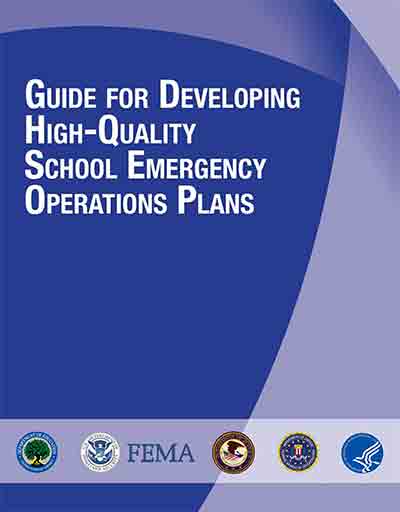Office of Attorney General of Texas, 2010. This manual serves as a practical guide for parents, school employees and policy makers in the state of Texas on issues involving crime in the school system. This document elucidates the laws, duties, liabilities and procedures in responding to school-related crime in Texas.
Tag: Disasters
Texas Emergency Management Toolkit
Texas School Safety Center, 2013.The Texas Education Code §37.108 states: "At least once every three years, each school district or public junior college district shall conduct a safety and security audit of the district's facilities. To the extent possible, a district shall follow safety and security audit procedures developed by the Texas School Safety Center or a comparable public or private entity". While the term "audit" is included in TEC §37.108, the process was developed as an ongoing assessment of a district’s safety and security. Audits should be an ongoing process with the aim of identifying hazards, threats, and vulnerabilities that might pose a danger to life or property and/or may interfere with a safe, secure and healthy environment that is conducive to teaching and learning. Attention to safety and security should not be thought of as an annual or a once-every three year "audit" event. Districts are encouraged to integrate ongoing safety and security assessments into everyday activities. This includes planning, training, and drilling of emergency procedures.
SECTION 1
Audit Reporting
SECTION 2
K-12 Safety and Security Audit Guide
SECTION 3
Higher Education Safety and Security Audit Guide
Texas School Safety Guide
Office of the Attorney General of Texas, 2007. Protecting our children from harm is more important today than ever before. This is especially true in school settings. Children must have a safe and positive learning environment in order to receive the education they deserve.
In recent years, tragic school shootings such as those at Virginia Tech University and Columbine High School in Colorado have focused the nation’s attention on the need for secure campuses. Here in Texas, we are committed to ensuring that schools are safe havens of learning for our children – free from violent tragedies and other behaviors that threaten students’ safety.
The Office of the Attorney General (OAG) is strongly committed to assisting local school administrators as they create and maintain a safe, positive learning environment for their students. To that end, we have joined with the Texas School Safety Center to offer several resources intended to foster school safety. The first of these resources is this School Safety Guide, a practical resource handbook from the OAG that covers the laws applicable to Texas public schools. This Guide can help provide direction to school officials in handling a variety of school safety and disciplinary problems.
Model School Safety Plan for Rhode Island
State of Rhode Island Emergency Management Agency, 2013. In July of 2013, Governor Chafee signed RIGL §16-21-24 into effect. The law requires RIEMA, in coordination with RIDE to develop a template for school districts to work with local police and fire departments to conduct a school safety assessment and create an emergency plan. School committees are now required on an annual basis to update school safety and emergency plans and procedures. By December 31st of each year, the Commissioner of Elementary and Secondary Education must present a safety assessment to the General Assembly and the Governor.
RIEMA, in collaboration with RIDE, the Department of Behavioral Healthcare, Developmental Disabilities, and Hospitals, the Rhode Island Department of Public Safety, Rhode Island State Police and the Division of the State Fire Marshal, and many other stakeholders developed the Model School Safety Plan in the wake of school incidents. The purpose of this joint initiative is to enhance preparedness and response procedures for school systems and local communities in the State of Rhode Island.
The plan is a 300-page strategic blueprint which incorporates best practices and state requirements into a guide that school districts can adopt or modify to meet their individual needs. The key documents in the new resource include an emergency planning guide and two FEMA publications regarding developing high-quality emergency operations for K-12 and Higher Educational institutions.
Delaware: School Safety Procedures Guide
Delaware Emergency Management Agency (DEMA), 2007. This guide outlines recommended procedures for responding to emergencies. A copy of this guide should be placed in every office, receptionist area, cafeteria and other places where people gather. Since the information is general, each workplace or building should tailor procedures to fit its own environment and capabilities. A comprehensive crisis management plan may be developed from this guide. For the most effective use, present guide to staff during training and review procedures frequently.
Guide for Developing High-Quality School Emergency Operations Plans
Department of Homeland Security (DHS)/Federal Emergency Management Administration (FEMA), Department of Justice (DOJ)/Federal Bureau Investigation (FBI), United States Department of Education (USDOE), & Department Health and Human Services (DHHS), 2013. Lessons learned from school emergencies highlight the importance of preparing school officials and first responders to implement emergency operations plans. By having plans in place to keep students and staff safe, schools play a key role in taking preventative and protective measures to stop an emergency from occurring or reduce the impact of an incident. Although schools are not traditional response organizations, when a school-based emergency occurs, school personnel respond immediately. They provide first aid, notify response partners, and provide instructions before first responders arrive. They also work with their community partners, i.e., governmental organizations that have a responsibility in the school emergency operations plan to provide a cohesive, coordinated response. Community partners include first responders (law enforcement officers, fire officials, and emergency medical services personnel) as well as public and mental health entities.
We recommend that planning teams responsible for developing and revising school EOPs use this document to guide their efforts. It is recommended that districts and individual schools compare existing plans and processes against the content and processes outlined in this guide. To gain the most from it, users should read through the entire document prior to initiating their planning efforts and then refer back to it throughout the planning process.
The guide is organized in four sections:
- The principles of school emergency management planning.
- A process for developing, implementing, and continually refining a school EOP with community partners (e.g., first responders and emergency management personnel) at the school building level.
- A discussion of the form, function, and content of school EOPs.
- “A Closer Look,” which considers key topics that support school emergency planning, including addressing an active shooter, school climate, psychological first aid, and information-sharing.
School Safety in Mississippi
Mississippi Department of Education, 2012. Safe schools are fundamental to students' school successes and achievements. Consequently, providing a safe and orderly school environment remains an ever-present priority of the Mississippi Department of Education. School safety should be addressed through a comprehensive approach that focuses on prevention, intervention and response planning. Systems and programs should be in place that create caring school communities where all students and staff feel safe and supported. Key to the process of building and maintaining safe schools is the development of active partnerships between schools and communities.
Comprehensive School Safety Guide for Minnesota
Homeland Security and Emergency Management. School emergency planning is a necessary but often unfamiliar task for many school administrators. Statute requires all Minnesota schools adopt a crisis management policy and develop individualized plans addressing potential violent crisis situations, emergencies and natural disasters. The Comprehensive School Safety Guide is designed to help simplify school emergency planning and guide school administrators and district emergency planning teams through the emergency planning process.
The updated and revised Comprehensive School Safety Guide is the fourth edition of Minnesota’s guidance for school emergency planning. The first Model Crisis Management Policy and school emergency procedures document was issued jointly by the Minnesota Department of Public Safety and the Minnesota Department of Education in 1999. Emergency procedures were revised in 2005 and the first Comprehensive School Safety Guide was published in 2008. The 2011 edition includes new guidance on emergency planning for students with disabilities, safe school assessments and recovery planning. Guidance on drills and exercises, school emergency response teams and student reunification has also been updated.
School emergency planning requires a cooperative effort. The Comprehensive School Safety Guide is intended for district emergency planning teams and community emergency response partners responsible for formulating or revising school emergency plans. Procedures in the Comprehensive School Safety Guide are general guidelines based on local, state and national best practices. Districts are encouraged to review these procedures in coordination with district policies and crisis plans. Procedures should be customized to fit specific school building sites and coincide with local emergency response procedures.
School Safety Planning Manual for Washington State
Office of Superintendent of Public Instruction, 2008. The School Safety Planning Manual: Essential Resources for Developing Comprehensive Safe School Plan is a guide for the K–12 public school system to create and implement safety plans in compliance with both state and federal laws.
Evaluating Earthquake Retrofitting Measures for Schools: A Cost-Benefit Analysis
Smyth, Deodatis, Franco, He, & Gurvich, 2004. Department of Civil Engineering and Engineering Mechanics, Columbia University. Based on a cost-benefit approach for evaluating seismic mitigation options for apartment buildings in Istanbul, Turkey, this paper presents a demonstration study for a hypothetical vulnerable school building. A probabilistic cost-benefit analysis provides a useful framework for assessing seismic mitigation measures, taking into consideration limited resources and social costs. The hypothetical school is analysed over a variety of time-horizons to determine the break-even point for investments for several seismic retrofitting options.











